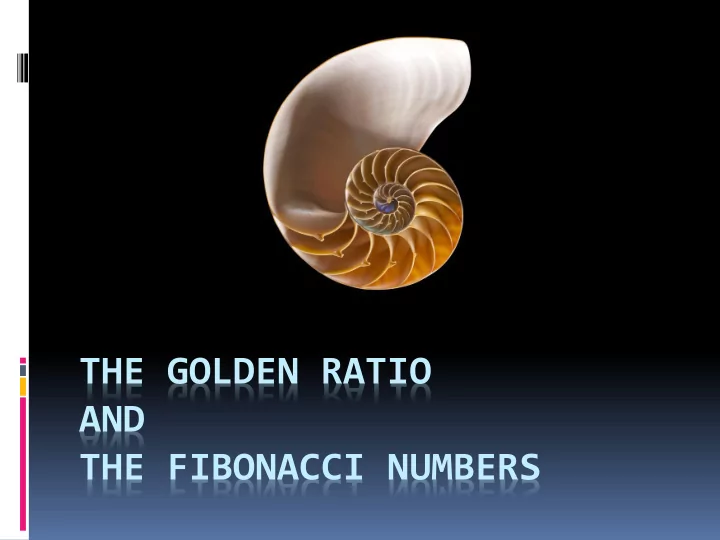

THE GOLDEN RATIO AND THE FIBONACCI NUMBERS
Common Measures 1 foot 2 feet 3 feet 3 2 Ratio = Ratio = 2 1 Common measure = 1 foot
25 inches 11 inches 36 inches 36 25 Ratio = Ratio = 25 11 Common measure = 1 inch
a b a + b 𝑏 + 𝑐 = 𝑏 𝑐 𝑏 Incommensurable! (no fraction of a foot can be used to measure this distance)
1.618033988749894…
The origins of are shrouded in the mists of time
The Golden Ratio: In modern times is denoted by the symbol phi: Known to Euclid (300 B.C.) as a result of solving: 𝑦 2 − 𝑦 − 1 = 0 A number of painters and architects have used the golden ratio in their work The length of a diagonal of a regular pentagram, whose sides have unit length, is Occurs in nature – represents a growth pattern
Legend and Speculation Was known to the ancient Egyptians. Was used to form the dimensions of the Great Pyramids of Egypt. Was applied to the design of the Parthenon. Was used in the design of Notre Dame in Paris. Was used in the construction of the Taj Mahal.
The Parthenon
Ratio of a Rectangle a b 𝑏 𝑐 Ratio =
Another Ratio a b a Ratio = 𝑏 + 𝑐 /𝑏 These two rectangles have a divine proportion if: 𝑏 + 𝑐 = 𝑏 𝑐 𝑏
The Algebra 𝑏 + 𝑐 = 𝑏 𝑐 𝑏 𝑐 𝑏 + 𝑐 = 𝑏 2 𝑏 2 − 𝑏𝑐 − 𝑐 2 = 0 Letting 𝑐 = 1 gives us: 𝑏 2 − 𝑏 − 1 = 0 Whose only positive solution is
Golden Ratio Numerically the golden ratio is: 1+√5 = = 1.61803 … 2 This comes from solving 𝑦 2 − 𝑦 − 1 = 0 using the quadratic formula: 𝑐 2 − 4𝑏𝑑 −𝑐 ± 2𝑏 All rectangle pairs that are in divine proportion to each other will have this ratio.
a b a Ratio = 𝑏 + 𝑐 /𝑏 If these two rectangles have a divine proportion then: 𝑏+𝑐 𝑏 𝑐 = 𝑏 =
Fibonacci Numbers
The Original Problem Stated by Fibonacci (whose original name was Leonardo of Pisa) in the year 1202 Gives a recursive rule for computing the total number of rabbit pairs under “ideal” reproductive circumstances.
Problem Statement Start with a rabbit pool containing one pair of newly born rabbits (one male and one female) A newly born rabbit takes one month to reach reproductive maturity The gestation period of a reproductively mature female rabbit is one month A female rabbit will always give birth to two rabbits – one male and one female This newly born pair is added to the rabbit pool Question: How big is the rabbit pool after 12 months? n months?
Young Pair Month 1 Mature Pair Month 2 Mature Pair Young Pair Month 3 Young Pair Mature Pair Mature Pair Month 4 Mature Pair Mature Pair Young Pair Mature Pair Mature Pair Mature Pair Mature Pair Mature Pair Mature Pair
Fibonacci Sequence Starting from 1 1, 1, 2, 3, 5, 8, 13, 21, 34, 55, 89, 144, … Starting from 0 0, 1, 1, 2, 3, 5, 8, 13, 21, 34, 55, 89, 144, …
In Flowers The pedal count of many flowers are Fibonacci numbers (this is a known growing pattern)
,2,3,5,8,13,21,34,55,89,… 1 white calla lily
1, ,3,5,8,13,21,34,55,89 ,… 2 Euphorbia
1,2, ,5,8,13,21,34,55,89 ,… 3 Trillium
1,2,3, , 8,13,21,34,55,89,… 5 Buttercup
1,2,3,5, , 13,21,34,55,89,… 8 Bloodroot
1,2,3,5,8, , 21,34,55,89,… 13 Black eyed Susan
1,2,3,5,8,13, ,34,55,89 ,… 21 Shasta Daisy
1,2,3,5,8,13,21, ,55,89 ,… 34 Field Daisies
1,2,3,5,8,13,21,34, , ,… 55 89 Michelmas Daisies
𝑔𝑗𝑐 𝑜 + 1 = lim 𝑔𝑗𝑐 𝑜 𝑜→∞
Approaching the Golden Ratio fib(n+1) fib(n)
1, 1, 2, 3, 5, 8, 13, 21, 34, … 2 1 5 3 13 8 8 5 3 2 1 1
Recommend
More recommend